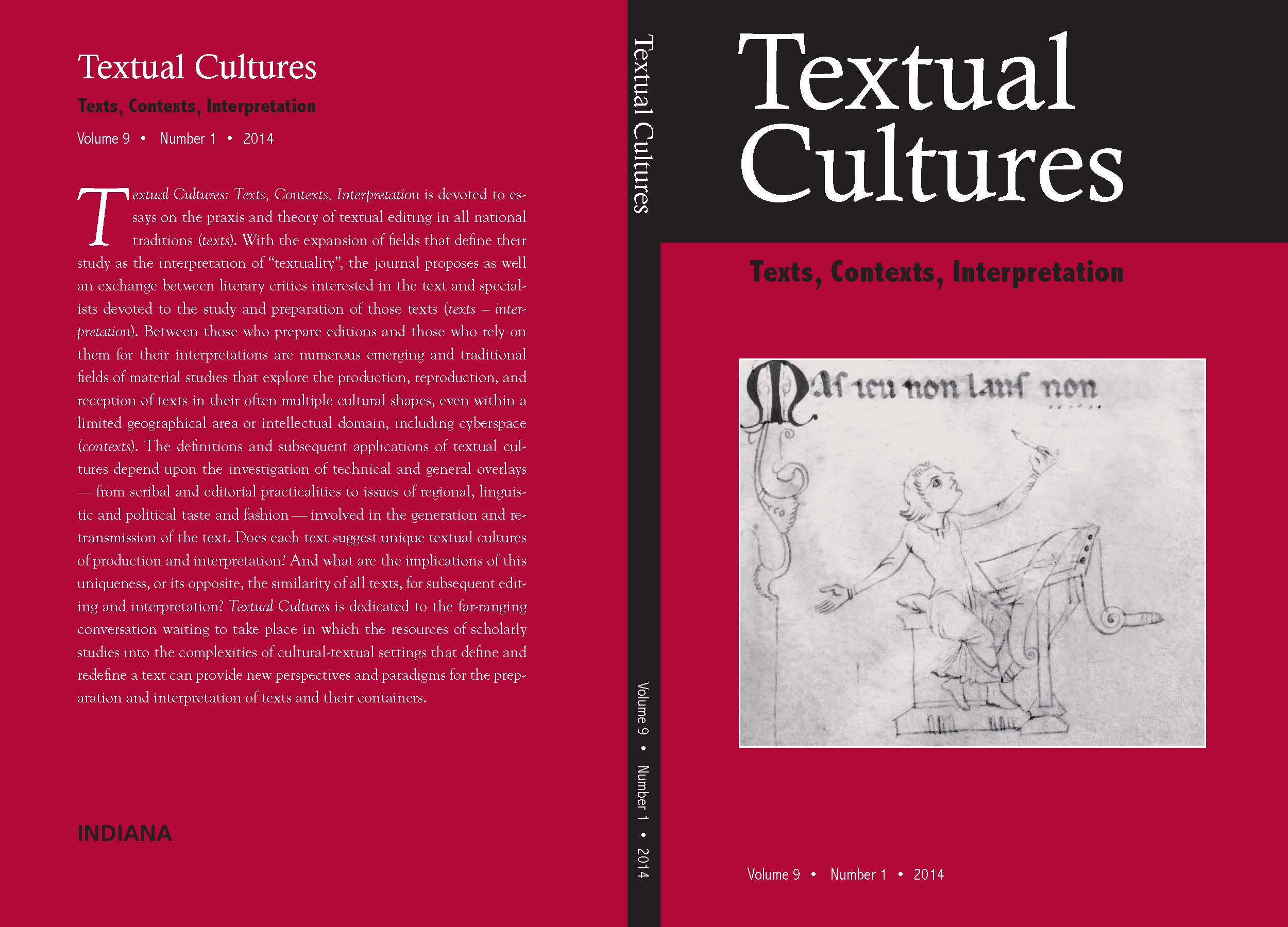Receiving and Rendering: Notes on the Edited Shakespeare Page
Main Article Content
Abstract
Downloads
Article Details
Authors who publish with this journal agree to the following terms:
- Authors retain copyright and grant the journal right of first publication with the work simultaneously licensed under a Creative Commons Attribution License (see:http://creativecommons.org/licenses/by/3.0/us/) that allows others to share the work with an acknowledgment of the work's authorship and initial publication in this journal.
- Authors warrant that their submission is their own original work, and that they have the right to grant the rights contained in this license. Authors also warrant that their submission does not, to the best of your knowledge, infringe upon anyone's copyright. If the submission contains material for which an author does not hold the copyright, authors warrant that they have obtained the unrestricted permission of the copyright owner to grant Indiana University the rights required by this license, and that such third-party owned material is clearly identified and acknowledged within the text or content of their submission.
- Authors are able to enter into separate, additional contractual arrangements for the non-exclusive distribution of the journal's published version of the work (e.g., post it to an institutional repository or publish it in a book), with an acknowledgment of its initial publication in this journal.
References
Alpers, Paul. 1996. What Is Pastoral? Chicago: University of Chicago Press.
Bach, Rebecca Ann. 2007. Shakespeare and Renaissance Literature before Heterosexual-ity. New York: Palgrave Macmillan.
Bevington, David, ed. 1998. Troilus and Cressida. London: Arden Shakespeare.
Charnes, Linda. 2009. Anticipating Nostalgia: Finding Temporal Logic in a Textual Anomaly. Textual Cultures: Texts, Contexts, Interpretation 4 (1):72 – 8 3.
Cheney, Patrick. 2007. “Introduction”. Shakespeare Studies 36:19–25.
De Grazia, Margreta. 1991. Shakespeare Verbatim: The Reproduction of Authority and the 1790 Apparatus. Oxford: Clarendon Press.
———. 2010. Anachronism. In Cultural Reformations: Medieval and Renaissance in Lit-erary History, edited by Brian Cummings and James Simpson, 13–32. Oxford: Oxford University Press.
Dusinberre, Juliet. 1975. Shakespeare and the Nature of Women. London: MacMillan.
——— , e d. 2006. As You Like It. London: Arden Shakespeare.
Edwards, Thomas. 1748. A supplement to Mr. Warburton’s edition of Shakespear. Being the Canons of criticism, and glossary, collected from the notes in that celebrated work, and proper to be bound up with it. London.
Erne, Lukas. 2008. Shakespeare’s Modern Collaborators. London: Continuum.
Erne, Lukas, and Margaret Jane Kidnie, eds. 2004. Textual Performances: The Mod-ern Reproduction of Shakespeare’s Drama. Cambridge: Cambridge University Press.
Evans, A. W. 1932. Warburton and the Warburtonians: A Study in Some Eighteenth-Century Controversies. London: Oxford University Press.
Furness, H. H., ed. 1890. As You Like It. Philadelphia: J. B. Lippincott.
Grafton, Anthony. 1997. The Footnote: A Curious history. Cambridge, Massachu-setts: Harvard University Press.
Hanmer, Thomas. 1743–44. The Works of Mr. William Shakespeare . . ., 6 vols. Lon-don.
Hinman, Charlton, ed. 1968. The First Folio of Shakespeare. New York: W. W. Norton.
Jackson, H. J. 2001. Marginalia: Readers Writing in Books. New Haven: Yale Univer-sity Press.
——— . 2 0 0 5 . Romantic Readers: The Evidence of Marginalia. New Haven: Yale Uni-versity Press.
Johnson, Samuel, ed. 1765. The Plays of William Shakespeare . . ., 8 vols. London.
King, John N., ed. 2010. Tudor Books and Readers: Materiality and the Construction of Meaning. Cambridge: Cambridge University Press.
Kinney, Arthur. 2004. Shakespeare’s Webs: Networks of Meaning in Renaissance Drama. New York: Routledge.
Knowles, Richard, ed. 1977. A New Variorum Edition of Shakespeare: As You Like It. New York: The Modern Language Association of America.
Lipking, Lawrence. 1977. The Marginal Gloss. Critical Inquiry 3 (4):6 0 9 –55.
Marcus, Leah S. 1996. Unediting the Renaissance: Shakespeare, Marlowe, Milton. New York: Routledge.
———. 2007. “Editing Shakespeare in a Postmodern Age”. In A Concise Companion to Shakespeare and the Text, edited by Andrew Murphy, 128–44. Oxford: Blackwell.
Montrose, Louis Adrian. 1981. “‘The Place of a Brother’ in As You Like It: Social Process and Comic Form”. Shakespeare Quarterly 32:28 –54.
Murphy, Andrew. 2003. Shakespeare in Print: A History and Chronology of Shakespeare Publishing. Cambridge: Cambridge University Press.
———. 2007. “The Birth of the Editor”. In A Concise Companion to Shakespeare and the Te x t, edited by Andrew Murphy, 93–108. Oxford: Blackwell.
Rackin, Phyllis. 2009. “Dated and Outdated: The Present Tense of Feminist Shake-speare Criticism”. In Presentism, Gender, and Sexuality in Shakespeare, edited by Evelyn Gajowski. New York: Palgrave Macmillan.
Sherman, William H. 2008. Used Books: Marking Readers in Renaissance England. Philadelphia: University of Pennsylvania Press.
Sinfield, Alan. 2006. Shakespeare, Authority, Sexuality: Unfinished Business in Cul-tural Materialism. London and New York: Routledge.
Theobald, Lewis, ed. 1733. The Works of Shakespeare, in Seven Volumes . . . London.
——— . 17 4 0 . The Works of Shakespeare: in Eight Volumes . . . London.
Warburton, William ed. 1747. The Works of Shakespear in Eight Volumes . . . London.
Warren, Michael, ed. 1989. The Complete King Lear, 1608–1623. Berkeley: University of California Press.
Williams, Raymond. 1973. The Country and the City. New York: Oxford University Press.
